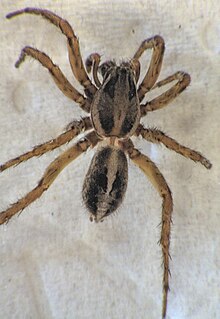
Wolf spiders are members of the family Lycosidae, from the Ancient Greek word "λύκος" meaning "wolf". They are robust and agile hunters with excellent eyesight. They live mostly in solitude and hunt alone, and do not spin webs. Some are opportunistic hunters pouncing upon prey as they find it or even chasing it over short distances. Some wait for passing prey in or near the mouth of a burrow.

Nursery web spiders (Pisauridae) is a family of araneomorph spiders first described by Eugène Simon in 1890. They resemble wolf spiders (Lycosidae) except for several key differences. Wolf spiders have two very prominent eyes in addition to the other six, while a nursery web spider's eyes are all about the same size. Additionally, female nursery web spiders carry their egg sacs with their jaws and pedipalps instead of attaching them to their spinnerets as wolf spiders do. When the eggs are about to hatch, a female spider builds a nursery "tent", places her egg sac inside, and stands guard outside, hence the family's common name. Like the wolf spiders, however, the nursery web spiders are roaming hunters that don't use webs for catching prey. They have a wide variety of prey, and larger species may prey upon vertebrates, particularly amphibians and fish.

Lycosa is a genus of wolf spiders distributed throughout most of the world. Sometimes called the "true tarantula", though not closely related to the spiders most commonly called tarantulas today, Lycosa spp. can be distinguished from common wolf spiders by their relatively large size. This genus includes the European Lycosa tarantula, which was once associated with tarantism, a dubious affliction whose symptoms included shaking, cold sweats, and a high fever, asserted to be curable only by the traditional tarantella dance. No scientific substantiation of that myth is known; the venom of Lycosa spiders is generally not harmful.

Hogna is a genus of wolf spiders with more than 200 described species. It is found on all continents except Antarctica.

The Artoriinae are a subfamily of wolf spiders. The monophyly of the subfamily has been confirmed in a molecular phylogenetic study, although the relationships among the subfamilies was shown to be less certain.

Artoriopsis is a genus of wolf spiders first described by Volker W. Framenau in 2007. They are endemic to Australia and are most diverse in the southern half of the continent, though A. anacardium is found in the tropical north of Australia. Their body size ranges from 3 to 11 mm, with males smaller than females. They appear to prefer open, vegetated or sandy areas of moderate humidity.

Trochosa is a large wolf spider genus found worldwide.
Zoica is a genus of wolf spiders in the family Lycosidae, containing twelve species.
Artoria is a genus of spiders in the family Lycosidae. It was first described in 1877 by Thorell. As of 2017, it contains 32 species.
Diahogna is a genus of spiders in the family Lycosidae. It was first described in 1960 by Roewer. As of 2017, it contains 4 Australian species.
Dingosa is a genus of spiders in the family Lycosidae. It was first described in 1955 by Roewer. As of 2017, it contains 6 species from Australia and from South America.

Geolycosa is a genus of wolf spiders first described in 1904.
Kangarosa is a genus of spiders in the family Lycosidae. It was first described in 2010 by Framenau. As of 2017, it contains 10 species from Australia.
Megarctosa is a genus of spiders in the family Lycosidae. It was first described in 1948 by Caporiacco. As of 2017, it contains 7 species.
Tasmanicosa is a genus of spiders in the family Lycosidae. It was first described in 1959 by Roewer. As of 2017, it contains 14 species, all from Australia.

Tetralycosa is a genus of Australian spiders in the family Lycosidae first described by Roewer in 1960, later revised by Framenau & Hudson to include thirteen species. Genetic studies show that these spiders all diverged from a common ancestor who likely wandered into the salty area and remained. They live exclusively in certain saline environments of Australia's interior, including coastal beaches, mound springs, clay pans, and salt lakes. There haven't been enough studies to establish a conservation status, but some species have only been found in solitary salt lakes, suggesting that the increase of mining, agriculture, recreational, and similar disturbances of these unique ecosystems may eventually lead to their extinction if not properly regulated.
Trochosippa is a genus of spiders in the family Lycosidae. It was first described in 1960 by Roewer. As of 2017, it contains 9 species.

Venatrix is a genus of wolf spiders first described by Carl Friedrich Roewer in 1960.
Portacosa is a genus of wolf spiders containing the single species, Portacosa cinerea. It was first described by V. W. Framenau in 2017, and is only found in Australia.









